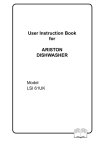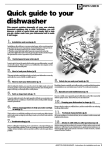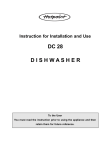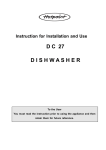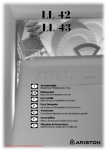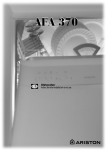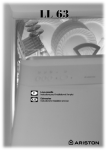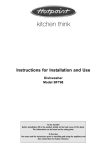Download Ariston LI 68 DUO Technical data
Transcript
LI 68 DUO GB Dishwasher Instructions for installation and use Quick guide to your dishwasher D ISHWASHER This manual explains pleasantly all your new electric household appliance has to offer. In addition, you will discover a world of useful hints and handy tips to help you get a better wash from your dishwasher and to make it last longer. 1. Installation and moving (p. 8) Installation, after delivery or your moving house, is the most important procedure for the correct operation of your dishwasher. Always check: 1. That the electricity system is in accordance with norms; 2. That the water inlet and outlet hoses are connected correctly; 3. That the dishwasher is level on the ground. It is worth it: for the longer life span and the correct operation of your dishwasher. 2. Control panel at your orders (p. 2) Learn to get to know the parts which make up your dishwasher, you will use it better for it. This is where you will find the description of the controls and the internal parts. 3. How to load your dishes (p. 3) This page includes useful tips to help you load your dishwasher correctly and make the most of all the available space. 4. How to start your dishwasher (p. 4) 8. Safety for you and your family (p. 10) After loading the dishes, you need to select the right wash cycle and measure out the correct dose of detergent and rinse aid. Reading these pages will help you through all the wash phases. Read this chapter carefully, as it will provide you with useful information on installation, use and maintenance safety. To avoid nasty surprises. 5. Salt: an important ally (p. 7) Using the right salt and in the right quantity will help you maintain your dishwasher in top condition, to wash better and to avoid possible damage caused by limescale. 6. Advice and suggestions to help you make savings as well (p.7) This is where you will find small tips on how to wash your dishes better and to help make savings by selecting a wash cycle which best suits the type of load. 7. Troubleshooting (p. 10) Before calling the technician, have a look here: a lot of problems can have an immediate solution. If you can't manage to solve it yourself, then call the Ariston helpline and any problem will be solved as quickly as possible. 9. Special care and maintenance (p. 11) Once in a while, once a month, spend a little time on the filter assembly and the sprayer arms. This is where you can learn how. 10. Keeping your dishwasher in shape (p.11) Respect the few rules you will find here, and the result will be an enduring top-shape dishwasher. 11. Technical characteristics (p. 2) All your appliance's technical data, in accordance with norms and regulations as always. 12. Ariston is still with you after purchase (p.12) Ariston supports its products by means of after-sales services and assistance, offering you special guarantees, professional assistance as well as quality spare parts and accessories. To find out more, call the Ariston Freefone Number. ARISTON DISHWASHER - Instructions for installation and use 1 D ISHWASHER Let's open up your dishwasher together How is it made? E Learn to get to know the parts which make up your dishwasher, you will use it better for it. E. Upper rack F. Top sprayer arm G. Rack height adjuster H . Lower rack G I. Bottom sprayer arm J. Salt container cap F K . Washing filter H J L . Detergent and rinse aid dispenser K M. Turbo dry fan I M L Control panel at your orders A. ON-OFF Button Press this button to switch the appliance on. B .ON-OFF Indicator light This light informs you that the dishwasher is on. C.Delayed start select button This button delays the start of the wash cycle you selected by 2, 4 or 6 hours. D. Delayed start indicator light This indicates that the delayed start has been set E. Extra drying button Press this button for greater drying Q. Rack selection button Press it to choose whether you want the dishes on the lower or upper rack to be washed. R. Rack indicator light Displays the rack selected S. Low salt indicator light This light warns you that it is time to add more salt. T. Low rinse aid indicator light This light warns you that it is time to add more rinse aid S M T Q P. Cycle select button Each time this button is pressed, one of the cycle indicator lights M will come on in sequence. M.Cycle indicator light This light informs you which cycle you have selected or the one in progress. C B A 1 2 P E R D Technical Characteristics This dishwasher conforms to the following European Community Directives: Technical characteristics Width cm. 59,5 Depth cm. 57 Height cm. 82 Capacity Mains water pressure 12 standard place settings 20 KPa÷ 1MPa (0,2 ÷10 bar) Power voltage See data plate Total absorber power See data plate Fuse See data plate 2 ARISTON DISHWASHER - Instructions for installation and use 73/23/EEC of 19/ 02/73 (Low Voltage) and subsequent modifications; 89/336/EEC of 03/ 05/89 (Electromagnetic Compatibility) and subsequent modifications; How to load your dishes D ISHWASHER Before washing, a few small steps can help you get a better wash and keep your dishwasher for longer. Remove the largest scraps of food left over on your plates, soak saucepans and frying pans with tough incrustations. After loading your dishes, make sure the blades on the sprayer arm turn well First of all. Before placing the dishes in the racks, remove the largest scraps of food left over on your plates, you will thus avoid blocking the filter, which would reduce the efficacy of the wash. If the saucepans and frying pans are very dirty, allow them to soak before being washed. To make it easier to load your dishes, pull the racks out. Multisystem racks This dishwasher model is fitted with newer and more modern upper and lower racks and a cutlery basket. They are made to provide greater flexibility in loading dishes, making them more suitable to meet your specific needs. The rack handles can be cleaned regularly: pull out the two fastening plugs, remove the handles and rinse them under running water. Put the handles back in place and fasten them using the plugs you removed previously. What goes into the lower rack? We recommend you place the most difficult dishes to wash into the lower rack: saucepans, lids, soup dishes and plates, but also: mugs, cups and glasses (see photos for load examples). Serving dishes and large lids: place them on the sides of the rack. Saucepans, salad bowls: must always be placed upside down Very deep dishes: place them obliquely, thus allowing water to run down them and cleaning them better Glasses and cups: Position them as indicated in the figure. The cutlery basket can be split up by pulling out the handle and removing the metal clip that keeps the two parts joined together. When you only have little cutlery to wash, you can use just half the basket; save space for other crockery or place the other half of the basket in the upper rack instead (see figures A and B). This basket is equipped with two removable grids: insert the cutlery one by one into the slots, with the handles at the bottom. Position them so that they don't touch. In this specific model, the cutlery basket is fitted with two detachable side compartments, as shown in figure A1, which can be hooked on either to the upper or lower rack, as required. What goes into the upper rack? Place delicate and lightweight dishes in the upper rack: glasses, tea cups and coffee cups, saucers - but plates too - shallow salad bowls, slightly dirty frying pans and shallow pans. Position light weight dishes in such a way as to avoid their being moved by the spray of water. The appliance can also be equipped with one or two tip-up compartments onto which you can place mugs and cups, as well as long sharp knives and serving cutlery. After loading the dishes, remember to check that the blades on the sprayer arms can turn freely without hitting against any dishes. Load examples lower rack upper rack How to adjust the top rack. The upper rack can be set in high or low position to enable you to organise your dishes effortlessly. Fig.C There are two handles on the sides of the upper rack: use these to adjust its height (see fig. C) A1 Where to put the different parts of the cutlery basket A B ARISTON DISHWASHER - Instructions for installation and use 3 D ISHWASHER Starting the dishwasher Ready, steady, go! You have loaded your dishes and you now have to set the wash cycle. It takes just one minute to learn how First of all. After performing all the operations described in the previous paragraphs, turn the water tap on completely, open the appliance door and press ON-OFF button "A": indicator light "B" comes on. Your appliance is now on and awaiting instructions. Selecting the wash cycle. Select the wash cycle by pressing button "P". Each time this button is pressed, one of the indicator lights "M" will come on in sequence, select the wash cycle you deem most suitable for the type of dishes to wash (take a look at page 6, where you will find the wash cycle table). Close the appliance door and after a few seconds, you will hear a short beep: the wash cycle has begun. Modifying a wash cycle in progress. But if you have chosen the wrong cycle, not to worry! You can modify the wash cycle in progress, if it has only just started. Open the appliance door carefully to avoid any hot water splashes, then keep button "P" pressed for approximately 5 seconds, until you hear 3 short beeps. Indicator light "M" will come off and at this point, all the settings will have been cancelled. You are now free to re-set the correct wash cycle. You've left out a dish? Well, it happens to everyone. Interrupt the wash cycle by opening the appliance door with the utmost care, as usual, then insert the dish you had forgotten. When you shut the appliance door, the cycle will start up from where you interrupted it. Finished? The end of the wash cycle is indicatedbyadoublebeepandtheflashing of the wash cycle indicator light "M". Open the dishwasher door, press the ON-OFF button as well, thus cutting off the electricity supply to the appliance. Turn off the water tap. Wait a few minutes before unloading the dishes: they are very hot! If you wait a little while, they dry better thanks to the steam. Empty the lower rack first. Make sure the wash cycle has ended before removing the dishes! There's been a power failure? Have you opened the dishwasher door? The wash cycle stops and then restarts when the electricity comes backonorwhenyouclosethedoor. Everything is under control! You decide when it starts. When you have loaded the dishes, you can choose when to start your dishwasher before setting the wash cycle desired. Press button "C" to delay the start of the wash cycle by 2, 4 or 6 hours. Each time you press it, you will hear a short beep and indicator light "D" corresponding to the selected delay will come on. Now you can select the desired wash cycle. Close the appliance door and, after you hear the beep, the countdown to the delayed start will begin. If, for example, you have set the delayed start to 6 hours, the 6 hour indicator light will flash, then the 4 hour indicator light will flash, and finally the 2 hour indicator light. A quick look at the indicator lights will keep you informed of the countdown progress at all times. Once this time is up, indicator light "D" will stop flashing and the wash cycle will begin. to start the wash cycle immediately, press the button in sequence until indicator light "D" comes off. Once you close the appliance door, the wash cycle set previously will begin. You want to wash on one rack only? Remember to use half the amount of detergent. Your dishwasher also allows you to wash half a load, to save water and electricity. Before setting any wash cycle whatsoever, press button "Q" repeatedly to select whether you want to run a half cycle on the upper or lower rack. Each time you press it, you will hear a short beep and indicator light "R" corresponding to the selected rack will come on. Have you changed your mind? If you change your mind and you wish to set a different delay, just open the appliance door, press button "C" and repeat the selection. If on the other hand you want to cancel the delay set and you wish 4 ARISTON DISHWASHER - Instructions for installation and use Do you want extra drying? Press button "E" before you start the selected wash cycle. A prolonged beep will inform you that you have selected extra drying, a short beep indicates it has been disabled. With extra drying, the wash cycle will last longer, to provide you with drier dishes. If you have delayed the start of your wash cycle, it is best if you do not modify anything while you wait during the countdown. If you really have to, then press button "P" and keep it pressed down for approximately 5 second You will hear 3 short beeps and all the settings will be cancelled. You can now repeat the programming operations. D ISHWASHER Detergent and rinse aid Only use specific dishwasher detergents. Pour the detergent into the dispenser on the inside of the door. Before the wash cycle starts! The detergent Loading the detergent To open lid A, press button B. The detergent should be poured into the two containers C and D up to the rim. Now you can close the lid: press it down until you hear it click. If you prefer to use the detergent in tablet form, then place one inside the container D and close the lid. A D C 25 gr. 5 gr. B The rinse aid. Loading the rinse aid. To open the dispenser, turn cap C anticlockwise. Take care when you pour in the rinse aid to avoid it overflowing. You can adapt the amount of rinse aid used by the dishwasher: regulate the adjuster F which you will find under lid C. Use the right amount of detergent: if you use too much, you will not get cleaner dishes, but just more environmental pollution. Keep your dishwasher detergent and rinse aid in a cool, dry place and away from children. It won't close! Check whether there is any detergent residue on the edges of the dispenser. It is due to this residue that the lid won't close. Get rid of it and you'll see that it closes. This product makes dishes sparkle more as it improves their drying. The rinse aid container is situated on the inside of the door. You should fill it up when the rinse aid indicator light T flashes. Useful tips F C You can choose from six different positions. It is normally set to 4. Proper dosage of the rinse aid improves drying. If drops of water remain on the dishes or spotting occurs, turn the dosage adjuster to a higher setting. If, on the other hand, the dishes have white streaks, then turn the dosage adjuster down to a lower setting. ARISTON DISHWASHER - Instructions for installation and use 5 D ISHWASHER Select the right wash cycle A wash cycle for every degree of soil Salt, rinse aid, the right amount of detergent and the correct wash cycle: this is the formula to get the best results and to keep your dishwasher in shape Note: in the auto wash cycles, the cycles could undergo some modifications due to the intervention of the sensor which evaluates how dirty the dishes are and optimises the cycle in accordance. &\FOH &\FOHVHOHFWLRQ LQVWUXFWLRQV 9HU\GLUW\GLVKHVDQGSDQV QRWWREHXVHGIRUGHOLFDWH LWHPV $XWR,QWHQVLYH 1RUPDOO\GLUW\SDQVDQG GLVKHV 6WDQGDUGGDLO\F\FOH $XWR1RUPDO 5DSLG (FRQRPLFDQGIDVWF\FOHWR EHXVHGIRUVOLJKWO\GLUW\ GLVKHV5XQF\FOH LPPHGLDWHO\DIWHUXVH 1RGU\LQJ 6RDNLQJ 3UHOLPLQDU\ZDVKF\FOHIRU GLVKHVZKLOHDZDLWLQJ FRPSOHWLRQRIWKHORDGZLWK WKHGLVKHVIURPWKHQH[W PHDO &U\VWDO (FRQRPLFDQGIDVWF\FOHWR EHXVHGIRUPRUHGHOLFDWH LWHPVZKLFKDUHVHQVLWLYHWR KLJKWHPSHUDWXUHV5XQ F\FOHLPPHGLDWHO\DIWHUXVH R $XWR'XR:DVK :DVKGLIIHUHQWLDWHGRQWKH WZRUDFNVGHOLFDWHIRU JODVVZDUHDQGJODVVHVRQ WKHXSSHUUDFNDQGKHDY\ GXW\IRUWKHSDQVRQWKH ORZHUUDFN (FRQRPLFDQGIDVWF\FOHWR EHXVHGIRUVOLJKWO\GLUW\ GLVKHV5XQF\FOH LPPHGLDWHO\DIWHUXVH &\FOHGHVFULSWLRQ "AUTO" wash cycles This means that your dishwasher is equipped with a sensor which evaluate how dirty your dishes are and allows these wash cycles to adjust automatically, to provide you with a more efficient and economic wash cycle. 'HWHUJHQWIRU SUHZDVK ZDVK 5LQVH $LG 3UHZDVKZLWKFROGZDWHU 3UHZDVKZLWKKRWZDWHUDW& ([WHQGHGZDVKDW& 5LQVHZLWKFROGZDWHU +RWULQVHDW& 'U\LQJ J SUHZDVKHVZLWKFROGZDWHU ([WHQGHGZDVKDW& +RWULQVHDW& 'U\LQJ J 6KRUWZDVKDW& &ROGULQVH J 6KRUWFROGZDVKWRSUHYHQWIRRG IURPGU\LQJRQWRWKHGLVKHV :DVKDW& /XNHZDUPULQVH +RWULQVHDW& 'U\LQJ 3UHZDVKZLWKFROGZDWHU :DVKDW& +RWULQVHDW& 'U\LQJ 6KRUWZDVKDW& &ROGULQVH +RWULQVHDW& 'U\LQJ 5DSLG:DVK'U\LQJ 6 ARISTON DISHWASHER - Instructions for installation and use J J J D ISHWASHER Never without salt Water in your home Water hardness varies according to where you live. If the water in your home is hard, without water softening, incrustations would form on your dishes. Your dishwasher is fitted with a water softener which uses special salt to get rid of limescale in the water. Loading the salt. Always use salt which is intended for dishwasher use. The salt container is situated underneath the lower rack, fill it up as follows: 1.Pull out the lower rack completely, unscrew and remove the container cap 2. Is it the first time you load the salt? First fill the container up with water (you won't have to do this again next time) 3. Put the dishwasher funnel on the hole and pour in approximately two kilos of salt. It is normal that some water comes out of the container. 4. Screw the cap back in place carefully. When should I load the salt? The salt container should be filled up when the low salt indicator light "S" flashes. Your appliance will remind you to do so for three consecutive wash cycles. Salt adjustment Your dishwasher can adjust its salt consumption according to the hardness of the water in your home. This way, you can optimise and customise your dishwasher's salt consumption (not too much, nor too little). To adjust salt consumption, do as follows: 1. Unscrew the salt container cap 2. There is an arrow on the neck of the container (see figure): if necessary, turn the arrow anticlockwise from the "-" setting to the "+" setting. Select the arrow position depending on the water hardness, referring to the table provided. Suggestions and advice for you. How to look after and protect the dishes you hold dear ■ Almost all silverware can be cleaned in a dishwasher. There are two exceptions: old silverware and silverware decorated with an oxidising agent. Hot water can loosen the handles on old silverware ad wear off the decorations on the other. Never let silverware come into contact with other metals: you will thus avoid stains and blackening Apart from making you save time and energy, your dishwasher disinfects your dishes, washing them at a high temperature. To prevent rust from forming, load the salt just before beginning a wash cycle. Water Hardness Salt consumption (grams/cycle) Autonomy (cycles\2kg) Clarke degrees °fH mmol/l Selector position 0 - 14 0 - 17 0 -1,7 / 0 / 14 - 36 18 - 44 1,8 - 4,4 "-" 20 60 36 - 71 45 - 89 4,5 - 8,9 MED 40 40 "+" 60 25 >71 > 89 > 8,9 You don't know how hard the water in your home is? Ask the company that supplies water in your area. Savings are easy Using your electric household appliances wisely helps you make savings and is good for the environment. Maximum load. To optimise consumption levels, try to use the dishwasher with a full load only. If it takes quite some time to fill up your dishwasher, use the soak cycle to avoid the formation of bad odours and caked-on food. ■ Silver plates and serving dishes should be washed immediately after use, especially if they have contained salt, eggs, olives, mustard, vinegar, fruit juices and cooked vegetables. The right wash cycle. Select the most suitable wash cycle for the type of load you have placed in the dishwasher. The choice of wash cycle depends on the type of dishes to wash and on how dirty they are. To select the right wash cycle, please consult the wash cycle table on page 6. ■ For particularly delicate dishes, we recommend you use the specific wash cycle offered by your dishwasher. ARISTON DISHWASHER - Instructions for installation and use 7 D ISHWASHER Installation and moving Your dishwasher has arrived After having bought or moved your dishwasher to another home, a correct installation ensures that your dishwasher will operate smoothly and efficiently. Choose where you want to install Hot water connection. your dishwasher, you can even Your dishwasher can be supplied place it so that its sides or back with hot water from the mains panel are side by side with furniture supply (if you have a central heating or up against the wall. The system with radiators) at a tempedishwasher is provided with water rature of no more than 60°C. supply and drain hoses, which can In this case, the wash cycle time be directed towards the left or right will be about 15 minutes shorter to facilitate appropriate and the wash will be slightly less installation. effective. The connection must be made to Levelling. hot water supply following the Once the appliance is positioned, same procedures as those indicated adjust the feet by screwing them in for the cold water connection. or out depending on how high you want it and to level it so that it is Anti-flooding protection horizontal. Make sure that it is not Your dishwasher is provided with a inclined more than 2 degrees. If the special system which blocks the appliance is level, it will help ensure water supply in the event of leaks its correct operation. inside the appliance. It is further equipped with a water inlet hose Adjusting the back Feet that can withstand extremely high Electrical connection. Insert the appliance into the cutout pressures and that turns bright red First of all, check that the mains and then adjust the height using the in the event of breakage. Safety in voltage and frequency values screws located on the front bottom the event of flooding is ensured by correspond to those stated on the part of the machine. Use a the second clear hose that contains rating plate located on the stainless screwdriver to turn the screws in the former and thus highlights the steel inner door of the appliance the clockwise or anti-clockwise latter when it has turned bright red. and that the electrical system to direction to increase or decrease It is vital that you check it on a which the dishwasher is connected the height respectively. regular basis: if you see it has turned is sized for the maximum current bright red, then you know you have indicated on said rating plate. Cold water connection. to replace it as soon as possible. Connect the cold water supply Call for an authorised technical hose to a 3/4 gas threaded engineer to come and replace it. connection, taking care to screw it tightly onto the tap. If the water hoses are new or have been out of Drain hose connection. use for an extended period of time, Fit the drain hose into a drain pipe let the water run to make sure it is with a minimum diameter of 4 cm clear and free of impurities before or place it over the sink. Avoid making the connection. If this restricting or bending it. Use the precaution is not taken, the water special plastic elbow provided (see inlet could get blocked, causing figure) to position it in the best damage to your dishwasher. possible way. The free end of the hose should be between 40 and 100 cm above the ground and should If the power not be immersed in water. socket to which the appliance is connected is not compatible with the plug, replace it with a suitable plug rather than using adapters or multiple plugs as these could cause overheating or burns. A 8 ARISTON DISHWASHER - Instructions for installation and use Earth: indispensable safety. Only now can you plug the appliance into a socket provided with an efficient earth connection (the system's earthing is a guarantee of safety provided for by law, make sure your system has it). Power supply wire. Check the power supply wire on a regular basis; if it is damaged, we recommend you have it replaced by an authorised technical Assistance service centre. The special plastic elbow should be fastened firmly onto the wall to prevent the drain hose from moving and allowing water to spill outside the drain. D ISHWASHER Electrical Connection Electrical Connection If your appliance is supplied with a 13 amp. fused plug it can be plugged into a 13 amp socket for immediate use. Before using the appliance please read the instruction below. Warning: this appliance must be earthed. The following operations should be carried out by a qualified electrician. Replacing the fuse: When replacing a faulty fuse, a 13 amp ASTA approved fuse to BS 1362 should always be used, and the fuse cover re-fitted. If the fuse cover is lost, the plug must not be used until a replacement is obtained. Replacement fuse covers: If a replacement fuse cover is fitted, it must be of the correct colours as indicated by the colouredmarkingorthecolourthat is embossed in words on the base of the plug. Replacements can be obtained directly from your nearest Service Depot. Removing the plug: If your appliance has a nonrewireable moulded plug and you should wish to remove it to re-route the mains cable through partitions, units etc., please esure that either: - the plug is replaced by a fused 13 amp re-wireable plug bearing the BSI mark of approval - or: - the mains cable is wired directly into a 13 amp cable outlet, controlled by a switch, (in compliance with BS 5733) which is accessible without moving the appliance. Disposing of the plug: Ensure that before disposing of the plug itself, you make the pins unusable so that it cannot be accidentally inserted into a socket. How to connect an alternative plug: The wires in this mains lead are coloured in accordance with the following code: Instruction for connecting cable to an altenative plug: Important: the wires in the mains lead are coloured in accordance with the following code: - Blue NEUTRAL (N) - Brown LIVE (L) - Green and Yellow EARTH (E) Green & Yellow - Earth Blue - Neutral Brown - Live As the colours of the wires in the mains lead may not correspond with the coloured markings identifying the terminal in your plug, proceed as follows: connect Green & Yellow wire to terminal marked E or coloured Green or Green & Yellow. Connect Brown wire to terminal marked L or coloured Red. Disposing of the appliance: When disposing of the appliance please remove the plug by cutting the mains cable as close as possible to the plug body and dispose of it as described above. GREEN & YELLOW BROWN BLUE 13 amp fuse CROSS-BAR CORD GRIP Connect Blue wire to terminal marked N or coloured Black. If a 13 amp plug (BS 1363) is used it must be fitted with a 13 amp fuse. A 15 amp plug must be protected by a 15 amp fuse, either in the plug or adaptor or at the distribution board. If you are in any doubt about the electrical supply to your machine, consult a qualified electrician before use. Caution: The dishwasher plug must be accessible even when the appliance is installed as a built-in unit so that maintenance can be done safely. ARISTON DISHWASHER - Instructions for installation and use 9 D ISHWASHER Troubleshooting If you have a problem, read this Your dishwasher may not work or not function properly. In many cases, these are problems which can be solved without having to call for a technician. Before calling the service centre, always check the points below. The dishwasher won't start ■ Can the sprayer arms turn freely? Tap off alarm If you have forgotten to turn the water tap on, your appliance will ■ Is the water supply tap turned The dishwasher won't remind you of this by sounding a on? few short beeps for a few minutes. ■ Is the water supply tap drain. Turn the tap on and your appliance connected to the hose properly? ■ Is the drain hose bent? will start up again after a few min■ Has the water in your home Limescale deposits or utes. Were you to be absent when been cut off? these beeps are sounded, the appli■ Is the pressure of the water a white film form on the dishes. ance will be blocked automatically supply sufficient? ■ Is the lid on the salt container and wash cycle 5 and 6 indicator ■ Is the hose bent? closed properly? lights (crystal and auto duo-wash) ■ Is the filter on the water supply ■ Is the rinse aid dosage correct? will flash rapidly. hose blocked? Turn the appliance off at the ON■ Is the dishwasher door open? Error messages OFF button, turn on the water tap Your dishwasher is equipped with and wait approximately 20 seconds The dishes are not a safety system which is able to before turning the appliance back clean. ■ Have you put the right amount detect any operating anomalies. on, the wash cycle will start up of detergent into the dispenser? These anomalies are reported by again. ■ Is the wash cycle suitable for one or two wash cycle indicator the dishes you have placed lights "M" flashing rapidly. Take a note of which lights are flashing, inside the appliance? ■ Are the filter and microfilter turn the appliance off and call for technical assistance. clean? You have checked everything, but the dishwasher still doesn't work and the problem persists? Call an authorised service centre nearyouandremembertomention: the type of malfunction the model mark (Mod .) and the serial number (S/N .) indicated on the rating plate located on the inner door, to one side. Never call upon the services of unauthorised technicians and always refuse spare parts that are not originals. Safety within your home Your dishwasher was built in accordance with the strictest international safety regulations. They protect you and your family. Read the instructions and information contained in this manual: they will provide you with useful hints as to installation, use and maintenance safety. To avoid nasty surprises. 1. Dispose of the packaging material carefully (follow the instructions on how to divide your rubbish up provided by your local Council) 2. After removing the packaging, check to make sure your appliance is intact. If in doubt, contact a qualified professional. 3. Your dishwasher must only be used by adults and for washing householddishes,accordingto the instructions included in this manual. Do not touch the appliance with wet hands or feet or barefoot. 4. We discourage the use of extension leads and multiple plugs. If the electricity supply wire is not long enough, then have it replaced with one of the correct length and remember that it should be free of bends or dangerous kinks. 5. If the appliance is not operating properly or if maintenance operations are necessary, disconnect the dishwasher from the mains power supply (unplug it!). 6. Keep children away from the dishwasherwhenitisopenand keep detergents out of their reach. 7. Your dishwasher is not to be installed outdoors, not even if the area is covered by a roof: it is extremely dangerous to leave it exposed to rain and thunderstorms. 8. Do not touch the heating element during or straight after a wash cycle. 9. Do not lean or sit on the door when it is open, as this could overturn the dishwasher. 10. If the appliance malfunctions, turn off the water inlet tap and disconnect the plug from the wall socket. Then try 10 ARISTON DISHWASHER - Instructions for installation and use consulting the section entitled "I you have a problem, read this". If you cannot resolve the problem, then call the service centre. 11. Once taken out of use, appliances must be made inoperable: cut the power supply wire and damage the door lock. I only want an authorised specialised technician with original Ariston guaranteed spare parts Care and maintenance D ISHWASHER Cleaning and special maintenance The filter assembly If you want consistent good results from your dishwasher, you need to clean the filter assembly. The food particles are removed from the wash water, allowing it to be recirculated during the cycle, filtered perfectly. For this reason, it is a good idea to remove the larger food particles trapped inside the cup C and the semi-circular filter A after each wash; pull the cup handle upwards to remove them. Just rinse them under running water. The entire filter assembly should be cleaned thoroughly once a month: cup C + semi-circular filter A + cylindrical filter B. Rotate filter B anticlockwise to remove it. For cleaning, use a non metallic brush. Reassemble the filter parts (as shown in the figure) and reinsert the whole assembly into the dishwasher. Position it into its housing and press downwards. The dishwasher is not to be used without filters. Improper replacement of the filters may reduce the efficiency of the wash and even damage your dishwasher. Cleaning the sprayer arms. Food residue may become encrusted onto the sprayer arms and block the holes where water comes out. Check the sprayer arms regularly and clean them once in a while (letters F and I How is it made?). Once in a while, once a month, spend a little time on the filter assembly and the sprayer arms. 1 B 2 A C Keep your dishwasher in shape Respecting these few rules ensures you will always have a reliable work companion by your side. After every wash. When the wash cycle has ended, always remember to turn off the water supply tap and to leave the appliance door ajar. This way, moisture and bad odours will not be trapped inside. Unplug the appliance. Before carrying out any cleaning or maintenance on the dishwasher, always remove the plug from the electricity socket. Do not run risks. No solvents! No abrasives! To clean the exterior and rubber parts of your appliance, do not use solvents or abrasive cleaning products. Use a cloth dampened with lukewarm soapy water only. If there are any stains on the surface of the appliance interior, use a cloth dampened with water and a little white vinegar, or a cleaning product specifically made for dishwashers. Going on holiday? When you go away for an extended period of time, we recommend you do the following: run a cycle with the dishwasher empty turn off the water inlet tap. leave the appliance door ajar This will help the seals last longer and prevent unpleasant odours from forming inside the appliance. Moving the appliance. Should the appliance have to be moved, try to keep it in a vertical position. If absolutely necessary, it can be positioned on its back. The seals. One of the factors that cause unpleasant odours to form inside the dishwasher is food that remains trapped in the seals. Periodic cleaning using a damp sponge will prevent this from occurring. Your dishwasher is not a waste disintegrator! Do not worry about removing every single bit of food residue from your dishes, but do get rid of bones, peel and rind and any other left-overs before placing them in the racks. Empty out all glasses and cups. ARISTON DISHWASHER - Instructions for installation and use 11 D ISHWASHER Stay in touch THANK YOU for choosing an Ariston appliance. We are confident you have made a good choice and that your new appliance will give many years of excellent service. And we're there when you need us. Register your purchase now This will confirm your entitlement to free spare parts for five years, and you could also be lucky enough to recover the cost of your purchase in our quarterly prize draw. Simply complete and return the Registration Form supplied with the appliance documents, using the FREEPOST envelope supplied. Or call the Registration Hotline on 0870 010 4305. Enjoy complete peace of mind. By registering now, you automatically qualify for a full year's guarantee on parts and labour PLUS free functional parts cover for a further 4 years, provided they are genuine Ariston spare parts fitted by an Ariston Service Engineer. We're as close to you as your telephone For direct access to Genuine Ariston Spare Parts and Accessories, call 0870 558 5850 and speak to our skilled staff who can help you to identify and purchase the item you require. For a Rapid Response to a problem with your appliance, call 0870 607 0805. We're open from Monday to Saturday (8am - 5.30pm weekdays, 9am - 5pm Saturday). We have our own department of highly trained Ariston service staff. For most calls, our Service Engineer can fix the problem on the first visit. Please have the following details to hand when you ring us: The nature of the problem, the Model Number and the Serial Number. These numbers can be found on the appliance and on the portion of the Registration Card which you retain. 12 ARISTON DISHWASHER - Instructions for installation and use Xerox Business Services - DocuTech Viale Aristide Merloni 47 - 60044 Fabriano (Italy) Tel +39 0732 6611 Fax +39 0732 662501 www.merloni.com 12/2001- 195033016.00 - Merloni Elettrodomestici
















